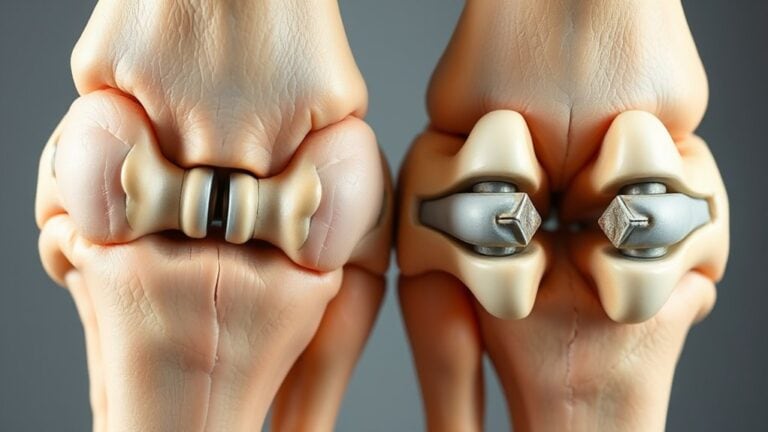Should you’ve noticed your skin peeling between your toes, many others share this experience, and it can be really frustrating. There are several culprits behind this issue, like fungal infections, eczema, or even just too much moisture. Fortunately? There are plenty of effective treatments and home remedies to help you out. You don’t have to suffer in silence, and grasping what’s going on is the initial step to finding relief. Let’s investigate those causes and how to tackle them effectively.
Causes of Skin Peeling Between Toes
At times it comes to skin peeling between your toes, several culprits could be at play, and comprehending them can help you find relief. One common issue is athlete’s foot, a fungal infection that thrives in warm, moist environments and leads to peeling skin and itching.
You could also experience contact dermatitis from shoes, which can cause redness and swelling. Another possibility is dyshidrotic eczema, revealing itchy blisters that peel after a few weeks, often triggered by stress.
Psoriasis, an autoimmune condition, can present thick, scaly patches that peel or bleed. In the end, trench foot occurs due to prolonged wet or cold exposure, leading to painful peeling. Identifying these causes is crucial for your path to recovery.
Symptoms Associated With Peeling Skin
At the time you notice peeling skin between your toes, it often comes with an irritating group of symptoms that can make daily life uncomfortable. You could experience itching and burning sensations, especially after taking off shoes or socks. The skin might appear scaly, cracked, or flaky, possibly with reddish or purplish discoloration. In some cases, you may even see blisters or oozing lesions, particularly with conditions like dyshidrotic eczema or a fungal infection. An unpleasant odor frequently accompanies, especially with athlete’s foot. Thickened or discolored toenails could show up, indicating a root issue like psoriasis or a fungal infection.
| Symptom | Description | Possible Cause |
|---|---|---|
| Itching | Irritating sensation | Fungal infection |
| Burning | Discomfort, often with swelling | Skin irritation |
| Scaly/Flaky Skin | Dry, peeling skin | Eczema or fungal issues |
| Blisters/Oozing | Fluid-filled bumps | Severe dermatitis |
Home Remedies for Peeling Skin
If you’re handling peeling skin between your toes, you’re not alone, and there are some effective home remedies you can try.
Soaking your feet in a vinegar solution or applying moisturizing oils like coconut oil can work marvels.
You may also find that using antifungal powders helps keep things in check while soothing the discomfort.
Vinegar Foot Soaks
Vinegar foot soaks are a simple yet effective remedy that many people rely on for soothing peeling skin between the toes. Using apple cider or white vinegar can help combat fungal infections like athlete’s foot. Here’s how they can assist you:
- Antifungal properties: Acetic acid in vinegar fights fungi causing peeling and itching.
- Skin pH balance: A soak of 1 part vinegar to 2 parts water helps restore your skin’s acidity, promoting healing.
- Quick relief: Soaking daily for 10–15 minutes can improve symptoms within 1–2 weeks, according to studies.
Just keep in mind not to overdo it! More than once a day could dry your skin further, so always moisturize after your soak for the best results.
Moisturizing With Oils
Moisturizing your skin can be a game changer, particularly while you’re handling peeling between your toes. Oils like Coconut, Tea Tree, Olive, and Jojoba offer both moisture and healing properties. Here’s how they can help:
| Oil | Benefits |
|---|---|
| Coconut Oil | Antifungal properties, great for dry, peeling skin. |
| Tea Tree Oil | Reduces fungal growth; soothe irritation whenever diluted. |
| Olive Oil | Deep hydration; perfect for overnight treatment. |
| Jojoba Oil | Mimics skin’s sebum, repairing moisture barriers. |
You can apply these oils regularly to keep the skin between your toes hydrated and healthy. Consistent use will help restore softness and combat dryness, giving your feet the relief they deserve.
Antifungal Powder Application
Peeling skin between your toes can be not just uncomfortable but also a little embarrassing. An effective way to combat this issue is through using antifungal powder. Here’s how you can apply it to help improve your condition:
- Use antifungal powders like clotrimazole or miconazole twice daily to target fungus causing athlete’s foot infections.
- Sprinkle the powder on clean, dry feet and inside your shoes to prevent moisture buildup.
- Choose powders with 2% tolnaftate and use them for 2-4 weeks for best results.
For better absorption, wear breathable cotton socks over the powder.
Don’t forget to reapply after swimming or sweating heavily to maintain that essential protection. Taking these steps will help keep your feet feeling comfortable and healthy.
When to Seek Medical Help
Provided your skin continues to peel between your toes for more than two weeks, it’s time to consult a healthcare professional.
Watch for signs of infection, like pus or swelling—those aren’t just annoying; they need immediate attention.
Don’t hesitate to reach out for help, especially should you have diabetes or notice serious changes, like red streaks or blackened skin; your feet deserve the best care!
Signs of Infection
Noticing skin peeling between your toes isn’t just a cosmetic issue; it’s essential to pay attention to what your body is telling you. Should you see any signs of infection, it’s time to seek medical care. Here are a few symptoms to watch for:
- Pus or drainage from the affected area
- Increased redness, swelling, or warmth to the touch
- Fever accompanying the peeling skin
Should you experience worsening pain or open sores that won’t heal within days, don’t hesitate to reach out for professional help.
Additionally, diabetic patients should be extra vigilant, as these signs might lead to severe complications. Staying informed and proactive can make all the difference in your health!
Persistent Symptoms After Treatment
When skin peeling between your toes lingers for more than two weeks, it’s vital to take a step back and evaluate the situation. Persistent symptoms after antifungal treatments could signal deeper issues.
Should you observe any spreading redness, swelling, or pus, it could indicate a secondary bacterial infection, which demands immediate attention. Diabetic patients ought to be especially vigilant, as the risk of complications like cellulitis or even sepsis rises with persistent peeling.
Always trust your instincts; seeking timely help is critical for your health.
Related Conditions and Complications
Peeling skin between your toes can signal more than just a dry patch; it could suggest concealed conditions that need attention. For instance, should you notice an athlete’s foot look, it’s essential to address it quickly since untreated fungal infections can spread to your toenails, leading to onychomycosis.
This common fungal infection can thicken and discolor your nails. Conditions like shoe contact dermatitis can cause a persistent rash that might worsen. Additionally, those with diabetes face a higher risk of foot ulcers due to skin peeling.
Should you experience dyshidrotic eczema, be cautious of secondary bacterial infections after blisters rupture. Always consult a healthcare provider when you’re unsure or notice concerning symptoms; don’t hesitate to seek immediate medical help.





